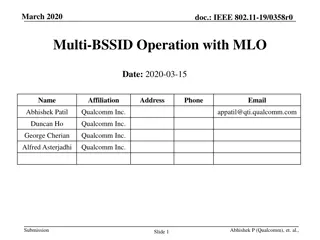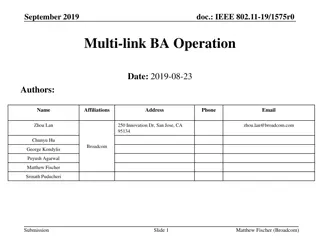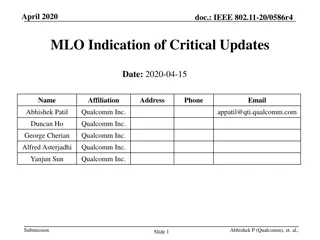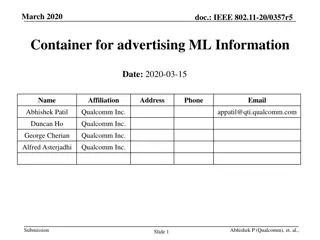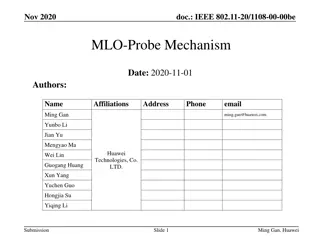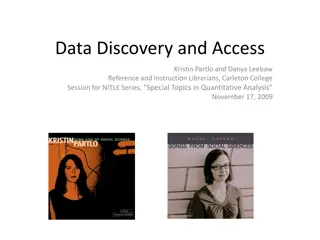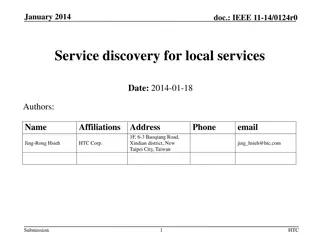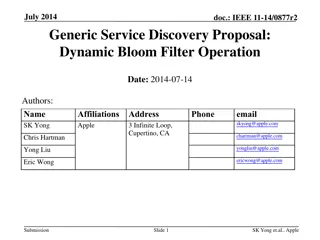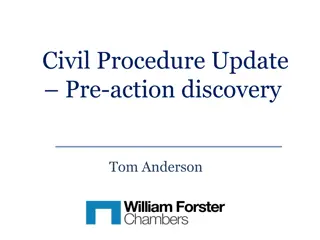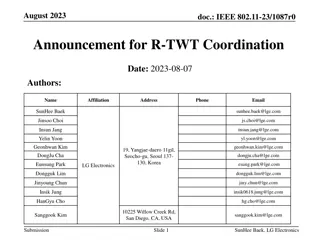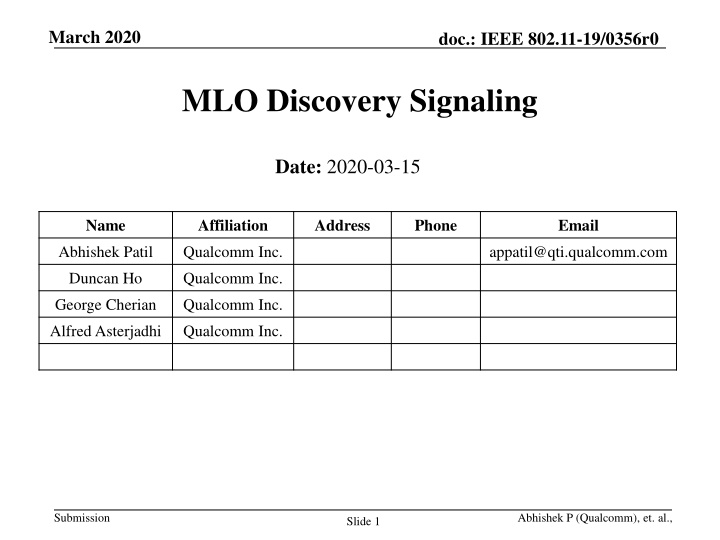
Efficient Framework for IEEE 802.11 MLO Discovery Signaling
Explore the detailed discussion on the efficient advertisement of MLO capabilities and information dissemination for IEEE 802.11 networks, focusing on APs and non-APs gathering essential data via beacon signals. The document delves into the classifications of information, per-link information strategies, and the inheritance model that MLOs should follow.
Download Presentation

Please find below an Image/Link to download the presentation.
The content on the website is provided AS IS for your information and personal use only. It may not be sold, licensed, or shared on other websites without obtaining consent from the author. If you encounter any issues during the download, it is possible that the publisher has removed the file from their server.
You are allowed to download the files provided on this website for personal or commercial use, subject to the condition that they are used lawfully. All files are the property of their respective owners.
The content on the website is provided AS IS for your information and personal use only. It may not be sold, licensed, or shared on other websites without obtaining consent from the author.
E N D
Presentation Transcript
March 2020 doc.: IEEE 802.11-19/0356r0 MLO Discovery Signaling Date: 2020-03-15 Name Affiliation Address Phone Email Abhishek Patil Qualcomm Inc. appatil@qti.qualcomm.com Duncan Ho Qualcomm Inc. George Cherian Qualcomm Inc. Alfred Asterjadhi Qualcomm Inc. Submission Abhishek P (Qualcomm), et. al., Slide 1
March 2020 doc.: IEEE 802.11-19/0356r0 Problem statement A non-AP MLD should be able to gather information about an AP MLD and all the links it supports upon receiving a beacon from any AP of the MLD Submission Slide 2 Abhishek P (Qualcomm), et. al.,
March 2020 doc.: IEEE 802.11-19/0356r0 What info. needs to be advertised? An AP of an AP MLD shall advertise at least the following information to aid discovery: Complete information of advertising AP such as capabilities and operational parameters MLD-level Information such as identity, authentication scheme(s), etc This is common to all the APs Complete or partial information of other APs of the MLD This contribution discusses the framework to support efficient advertisement of MLO capabilities A subsequent contribution discusses the actual element/fields to carry this information Submission Slide 3 Abhishek P (Qualcomm), et. al.,
March 2020 doc.: IEEE 802.11-19/0356r0 Classification of information Advertising link s Information Carried same as today for legacy compliance individual elements (e.g., EHT/HE/(V)HT Cap/Op elements) MLD (common) information Applies to all APs of the MLD Per-link information Carries information of all APs of the MLD other than the advertising AP This information can be partial or complete See later slides for details MLD Common Advertising Link s Information (AP 1) AP 2 AP 4 AP 3 Individual elements Information of other APs of the MLD Submission Slide 4 Abhishek P (Qualcomm), et. al.,
March 2020 doc.: IEEE 802.11-19/0356r0 Per-link information: Complete vs Partial An AP may include complete or partial information of another link Each approach has its pros and cons. Complete profile of a link AP s beacon includes full information about another link Pros: non-AP gets all the information on one link (avoids scanning the other link) Cons: can lead to beacon bloating Partial profile of a link AP s beacon identifies the link (Op Class, Channel, BSSID) and provides basic information (including indication of critical updates). Pros: prevents beacon bloating Cons: non-AP STA may need to scan the other link MLO framework should allow both options Submission Slide 5 Abhishek P (Qualcomm), et. al.,
March 2020 doc.: IEEE 802.11-19/0356r0 Inheritance Model An MLD is expected to have certain parameters that are same for multiple links When advertising complete information, an inheritance model (same as 11ax Multi-BSSID feature) is recommended To prevent duplication of information and address beacon bloating Any parameter not advertised in a link s profile is the same as the advertising link Other properties from multiple BSSID feature, such as profile straddling and non-inheritance, would apply here. Submission Slide 6 Abhishek P (Qualcomm), et. al.,
March 2020 doc.: IEEE 802.11-19/0356r0 Benefits of the framework The framework discussed in this contribution is extensible and would be applicable in other scenario Active scanning: Probe Req/Resp frames use this framework to provide capabilities information ML Setup: Frames exchanged during ML setup use this frame to carry exhaustive information of all the links. The information advertised during discovery is expected to be rudimentary compared to that exchanged during setup MLD Common Advertising Link s Information (STA 1) STA 2 STA 4 STA 3 Individual elements Information of other STAs of the MLD Submission Slide 7 Abhishek P (Qualcomm), et. al.,
March 2020 doc.: IEEE 802.11-19/0356r0 Summary This contribution discusses the topic of multi-link capability advertisement and provides a flexible framework to carry an MLD s information. Further, the contribution proposes a couple of schemes to help reduce frame bloating Advertising STA may use an inheritance model to avoid duplication of information advertised for other links. Inheritance model same as 11ax multiple BSSID feature Advertising STA may advertise partial information of other links Identify the link and provide rudimentary information Submission Slide 8 Abhishek P (Qualcomm), et. al.,
March 2020 doc.: IEEE 802.11-19/0356r0 SP #1 Do you agree to classify the information that an MLD provides in its mgmt. frames, during discovery and ML setup, as described below? Advertising link s Information Capabilities and Operational parameter of the STA transmitting the frame MLD (common) Information Information common to all the STAs of the MLD Per-link information Capabilities and Operational parameter of all other STAs of the MLD other than the advertising STA Y: N: A: Submission Slide 9 Abhishek P (Qualcomm), et. al.,
March 2020 doc.: IEEE 802.11-19/0356r0 SP #2 Do you support that the MLO framework should follow an inheritance model (as described for 11ax multiple BSSID feature) to prevent frame bloating when advertising complete information of other links? Note: this includes properties such as profile straddling across multiple elements and non-inheritance Y: N: A: Submission Slide 10 Abhishek P (Qualcomm), et. al.,
March 2020 doc.: IEEE 802.11-19/0356r0 SP #3 Do you support that an AP MLD may advertise partial information of other links to prevent frame bloating? Y: N: A: Submission Slide 11 Abhishek P (Qualcomm), et. al.,
March 2020 doc.: IEEE 802.11-19/0356r0 SP #4 Do you support that a STA of non-AP MLD shall include in its Probe Request an indication that it supports MLO operation? Y: N: A: Submission Slide 12 Abhishek P (Qualcomm), et. al.,
March 2020 doc.: IEEE 802.11-19/0356r0 SP #5 Do you support that an AP of an AP MLD shall not include MLO information (i.e., MLD/common info. and info. of other links of the AP MLD) when responding, with an individually addressed Probe Response frame, to a Probe Request frame from a non-AP STA that has not indicated support for MLO? Y: N: A: Submission Slide 13 Abhishek P (Qualcomm), et. al.,
March 2020 doc.: IEEE 802.11-19/0356r0 APPENDIX Submission Slide 14 Abhishek P (Qualcomm), et. al.,
March 2020 doc.: IEEE 802.11-19/0356r0 Inheritance Model Common/MLD Advertising Link s Information (STA 1) STA 2 STA 4 STA 3 Capabilities and parameters different from the advertising link Information of other STAs of the MLD (link profiles) Non-inheritance Submission Slide 15 Abhishek P (Qualcomm), et. al.,
March 2020 doc.: IEEE 802.11-19/0356r0 Related motion [Motion 32] 802.11be defines mechanism(s) for multi-link operation that enables the following: Indication of capabilities and operating parameters for multiple links of an AP MLD. Negotiation of capabilities and operating parameters for multiple links during a single setup signaling exchange. AP MLD advertises capability and operational parameters for multiple links [Motion 21] 802.11be supports a mechanism for multi-link operation: An AP affiliated with an AP MLD can indicate the capabilities and operational parameters for one or more STAs of the multi-link device. A non-AP STA affiliated with a non-AP MLD can indicate the capabilities for one or more non-AP STAs of the non-AP MLD. Specific information of capabilities and operational parameters of multi-link device is TBD. AP and non-AP MLDs provide their capabilities and operational parameters for multiple links [Motion 26] A MLD can indicate capability to support exchanging frames simultaneously on a set of affiliated STAs to another MLD. advertise MLD/common information [Motion 38] A MLD that supports multiple links can announce whether it can support transmission on one link concurrent with reception on the other link for each pair of links. NOTE 1 The 2 links are on different channels. NOTE 2 Whether to define a capability of announcing the support transmission on one link concurrent with transmission on the other link is TBD. advertise common information such as STR capabilities Submission Slide 16 Abhishek P (Qualcomm), et. al.,


